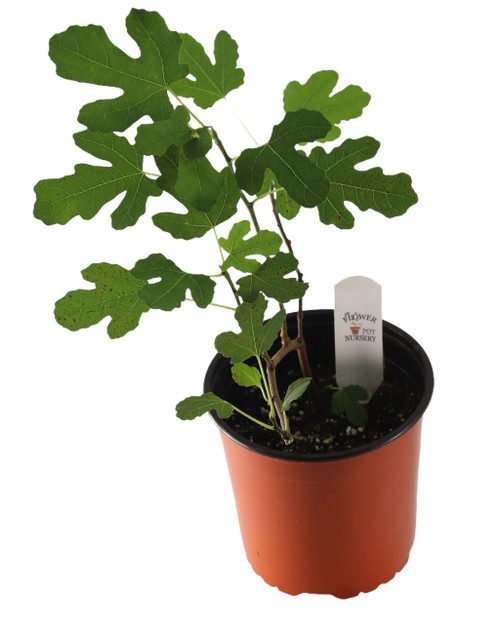The fig contains the edible fruit of Ficus carica, a species of small tree in the flowering plant family Moraceae. Native to the Mediterranean and western Asia, it has been cultivated since ancient times and is now widely grown throughout the world, both for its fruit and as an ornamental plant. Ficus carica is the type species of the genus Ficus, containing over 800 tropical and subtropical plant species.
A fig plant is a small deciduous tree or large shrub growing up to 7-10 m (23-33 ft) tall, with smooth white bark. Its large leaves have three to five deep lobes. Its fruit (referred to as syconium, a type of multiple fruit) is tear-shaped, 3-5 cm (1-2 in) long, with a green skin that may ripen toward purple or brown, and sweet soft reddish flesh containing numerous crunchy seeds. The milky sap of the green parts is an irritant to human skin. In the Northern Hemisphere, fresh figs are in season from late summer to early autumn. They tolerate moderate seasonal frost and can be grown even in hot-summer continental climates.
Figs can be eaten fresh or dried, or processed into jam, rolls, biscuits and other types of desserts. Since ripe fruit does not transport and keep well, most commercial production is in dried and processed forms. Raw figs contain roughly 80% water and 20% carbohydrates, with negligible protein, fat and micronutrient content. They are a moderate source of dietary fiber.
In 2018, world production of raw figs was 1.14 million tonnes, led by Turkey and North African countries (Egypt, Morocco, and Algeria) as the largest producers, collectively accounting for 64% of the total.
The word fig, first recorded in English in the 13th century, derives from (Old) French figue, itself from Occitan (Provençal) figa, from Romance *fica, from Classical Latin ficus (fig or fig-tree). Italian has fico, directly derived from Latin ficus. The name of the caprifig, Ficus caprificus Risso, is derived both from Latin capro (billygoat) and English fig.
Ficus carica is a gynodioecious, deciduous tree or large shrub that grows up to 7-10 m (23-33 ft) tall, with smooth white bark. Its fragrant leaves are 12-25 cm (4+1⁄2-10 in) long and 10-18 cm (4-7 in) wide, and are deeply lobed (three or five lobes).
The fig fruit develops as a hollow, fleshy structure called the syconium that is lined internally with numerous unisexual flowers. The tiny flowers bloom inside this cup-like structure. Although commonly called a fruit, the syconium is botanically an infructescence, a type of multiple fruit. The small fig flowers and later small single-seeded (true) fruits line its interior surface. A small opening or ostiole, visible on the middle of the fruit, is a narrow passage that allows the specialized fig wasp, Blastophaga psenes, to enter the inflorescence and pollinate the flowers, after which each fertilized ovule (one per flower, in its ovary) develops into a seed. At maturity, these 'seeds' (actually single-seeded fruits) line the inside of each fig.
The edible mature syconium develops into a fleshy false fruit bearing the numerous one-seeded fruits, which are technically druplets. The whole fig fruit is 3-5 cm (1-2 in) long, with a green skin that sometimes ripens toward purple or brown. Ficus carica has milky sap, produced by laticifer cells. The sap of the green parts is an irritant to human skin.
Give credit where credit is due: Wikipedia 2022
FlowerPotNursery Celeste Fig Tree Ficus carica Celeste 1 Gallon Pot
The Flower Pot Nursery
$25.18
- SKU:
- FCCE1G1022










